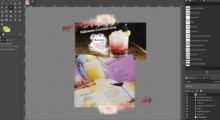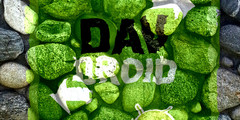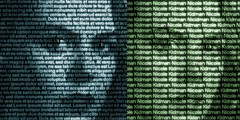Proposal for erasing background from an image
This discussion is connected to the gimp-developer-list.gnome.org mailing list which is provided by the GIMP developers and not related to gimpusers.com.
This is a read-only list on gimpusers.com so this discussion thread is read-only, too.
| Proposal for erasing background from an image | John Tapsell | 02 Mar 07:24 |
| Proposal for erasing background from an image | Simon Budig | 02 Mar 09:05 |
| Proposal for erasing background from an image | Ofnuts | 02 Mar 22:22 |
| Proposal for erasing background from an image | Jay Smith | 02 Mar 22:51 |
| Proposal for erasing background from an image | John Tapsell | 04 Mar 15:25 |
| Proposal for erasing background from an image | Ell via gimp-developer-list | 04 Mar 23:43 |
| Proposal for erasing background from an image | John Tapsell | 07 Mar 04:52 |
Proposal for erasing background from an image
Hi all,
I'm guessing this is frowned on but I've written this up on my blog here:
https://johnflux.com/2017/03/02/erasing-background-from-an-image/
It's mostly images and latex equations, so it's much better to read it there. I've pasted it below anyway.
Is anyone interested in this?
I have two opaque images - one with an object and a background, and another with just the background.
I want to subtract the background from the image so that the alpha blended result is visually identical, but the foreground is as transparent as possible.
I'm sure that this must have been, but I couldn't find a single correct way of doing this!
I asked a developer from the image editor gimp team, and they replied that the standard way is to create an alpha mask on the front image from the difference between the two images. i.e. for each pixel in both layers, subtract the rgb values, average that difference between the three channels, and then use that as an alpha.
But this is clearly not correct. Imagine the foreground has a green piece of semi-transparent glass against a red background. Just using an alpha mask is clearly not going to subtract the background because you need to actually modify the rgb values in the top layer image to remove all the red.
So what is the correct solution? Let's do the calculations.
If we have a solution, the for a solid background with a semi-transparent foreground layer that is alpha blended on top, the final visual color is:
$latex out_{rgb} = src_{rgb} * src_{alpha} + dst_{rgb} \cdot (1-src_{alpha})$
We want the visual result to be the same, so we know the value of $latex out_{rgb}$ - that's our original foreground+background image. And we know $latex dst_{rgb}$ - that's our background image. We want to now create a new foreground image, $latex src_{rgb}$, with the maximum value of $latex src_{alpha}$.
So to restate this again - I want to know how to change the top layer $latex src$ so that I can have the maximum possible alpha without changing the final visual image at all. I.e. remove as much of the background as possible from our foreground+background image.
Note that we also have the constraint that for each color channel, that $latex src_{rgb} \le 1$ since each rgb pixel value is between 0 and 1. So:
$latex src_{alpha} \le (out_{rgb} - dst_{rgb})/(1-dst_{rgb})$
So:
$latex
src_{alpha} = Min((out_r - dst_r)/(1-dst_r), out_g - dst_g)/(1-dst_g),
out_b - dst_b)/(1-dst_b))\\
src_{rgb} = (dst_{rgb} \cdot (1-src_{alpha}) - out_{rgb})/src_{alpha}
$
Proposal
Add an option for the gimp eraser tool to 'remove layers underneath', which grabs the rgb value of the layer underneath and applies the formula using the alpha in the brush as a normal erasure would, but bounding the alpha to be no more than the equation above, and modifying the rgb values accordingly.
Proposal for erasing background from an image
John Tapsell (johnflux@gmail.com) wrote:
So to restate this again - I want to know how to change the top layer $latex src$ so that I can have the maximum possible alpha without changing the final visual image at all. I.e. remove as much of the background as possible from our foreground+background image.
This is what color-to-alpha does. Except that it uses a constant color for the whole image. It might be interesting to convert this to a gegl op that takes two input drawable and picks the "background color" from each corresponding pixel in the background image.
Should be an easy fun hack. Who wants to take it?
Bye, Simon
simon@budig.de http://simon.budig.de/
Proposal for erasing background from an image
On 02/03/17 10:05, Simon Budig wrote:
John Tapsell (johnflux@gmail.com) wrote:
So to restate this again - I want to know how to change the top layer $latex src$ so that I can have the maximum possible alpha without changing the final visual image at all. I.e. remove as much of the background as possible from our foreground+background image.
This is what color-to-alpha does. Except that it uses a constant color for the whole image. It might be interesting to convert this to a gegl op that takes two input drawable and picks the "background color" from each corresponding pixel in the background image.
Should be an easy fun hack. Who wants to take it?
Bye, Simon
Fun hack, but would it be useful in practice? Do we want the lion to be partially transparent because its hair is more or less the color of the dry grass (with some help from Darwin). Try the two pictures in difference mode, and check all the places that are near black.
Proposal for erasing background from an image
On 03/02/2017 05:22 PM, Ofnuts wrote:
On 02/03/17 10:05, Simon Budig wrote:
John Tapsell (johnflux@gmail.com) wrote:
So to restate this again - I want to know how to change the top layer $latex src$ so that I can have the maximum possible alpha without changing
the final visual image at all. I.e. remove as much of the background as possible from our foreground+background image.This is what color-to-alpha does. Except that it uses a constant color for the whole image. It might be interesting to convert this to a gegl op that takes two input drawable and picks the "background color" from each corresponding pixel in the background image.
Should be an easy fun hack. Who wants to take it?
Bye, Simon
Fun hack, but would it be useful in practice? Do we want the lion to be partially transparent because its hair is more or less the color of the dry grass (with some help from Darwin). Try the two pictures in difference mode, and check all the places that are near black.
If I understand this correctly, an example useful in practice, but the opposite direction (fill the background instead of clearing it is in a picture like this (postage stamp surrounded by a black background):
http://jsa.viewimage.net/jsa/web/Lists/Sweden/SpecStamps/sc0012a-f12g2_used-fvfplus_135668_r_l.jpg
(However, I selected this example image to show a problem -- that the background is "connected" to the dark areas of the postmark where the postmark reaches the edge of the stamp.)
For 15+ years I have been trying, without success, to solve this overall situation and automate (or have a useful manually operated tool) the process of filling the background with 100% black. The scans are done on a black background (but it is impossible to scan it 100% black without distorting other aspects of the image); I have attempted using other contrasting/unique colors for the background during scanning with the idea of converting them to black, but there is always some sort of halo or bleeding at the edge of the stamp's perforations, even when there is not the "postmark problem".
Jay Smith
Proposal for erasing background from an image
On 3 March 2017 at 07:22, Ofnuts wrote:
On 02/03/17 10:05, Simon Budig wrote:
John Tapsell (johnflux@gmail.com) wrote:
So to restate this again - I want to know how to change the top layer $latex src$ so that I can have the maximum possible alpha without changing
the final visual image at all. I.e. remove as much of the background as possible from our foreground+background image.This is what color-to-alpha does. Except that it uses a constant color for the whole image. It might be interesting to convert this to a gegl op that takes two input drawable and picks the "background color" from each corresponding pixel in the background image.
Should be an easy fun hack. Who wants to take it?
Bye, Simon
Fun hack, but would it be useful in practice? Do we want the lion to be
partially transparent because its hair is more or less the color of the dry grass (with some help from Darwin). Try the two pictures in difference mode, and check all the places that are near black.
This is why I was suggesting that we do it with an option for the eraser. So that the user can have that manual control over it. How hard would it be to do this with the erasure tool?
Thanks,
John
_______________________________________________ gimp-developer-list mailing list
List address: gimp-developer-list@gnome.org List membership: https://mail.gnome.org/mailman /listinfo/gimp-developer-list
List archives: https://mail.gnome.org/archives/gimp-developer-list
Proposal for erasing background from an image
On 03/02/2017 02:24 AM, John Tapsell wrote:
Hi all,
I'm guessing this is frowned on but I've written this up on my blog here:
Absolutely not frowned upon :)
...
Hate to be a buzzkill, but it's already doable: clone tool + color erase mode + registered alignment.
Note that this technique might not work as well as you imagine. For each pair of background/output colors, what you essentially do is pass a ray from the background color, towards the output color, and look for the ray's intersection with the hull of the RGB cube. This point is your foreground color, and the alpha is the relative position of the output color along the background-foreground segment. This means, that all resulting foreground colors are on the hull of the color cube (i.e., fully saturated, including black, or full-value), and, conversely, all output colors that aren't on the hull result in semi-transparent foreground pixels.
Something that might be fun to try is this: suppose you have two pairs of background/background+foreground images, where the backgrounds are different, while the foreground object aligns (as much as possible) across the two images Then, at each pixel, you have two background->output rays, and, ideally, the true foreground color is their point of intersection. Most chances are that the rays won't intersect exactly, because of imperfect alignment/differences in color, but you can still look for the pair of points, one along each ray, that minimize the distance between each other; each one would be the foreground color for the corresponding image pair.
That being said, I imagine you'd need such a controlled environment to get good results with this, while there are usually simpler alternatives, that this strikes me as something that will only be useful is very specialized cases.
--
Ell
Proposal for erasing background from an image
On 5 March 2017 at 08:43, Ell via gimp-developer-list < gimp-developer-list@gnome.org> wrote:
On 03/02/2017 02:24 AM, John Tapsell wrote:
Hi all,
I'm guessing this is frowned on but I've written this up on my blog here:
Absolutely not frowned upon :)
...
Hate to be a buzzkill, but it's already doable: clone tool + color erase mode + registered alignment.
Awesome!
I tested it out, and it actually worked really well for my specific use case. I wanted to erase the color from a shadow, leaving just the shadow, and it did that beautifully.
In the example with the lion, it works really well when you have a yellow mane against a blue sky. But completely wrong for a yellow body against yellow wheat.
I updated the blog post with pictures if you're interested:
https://johnflux.com/2017/03/02/erasing-background-from-an-image/











